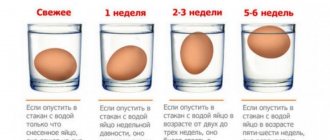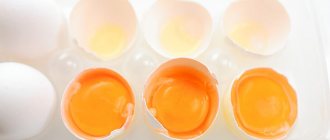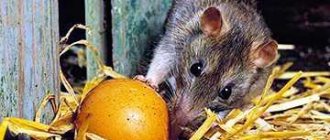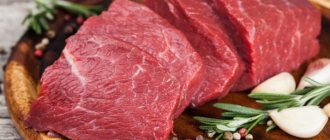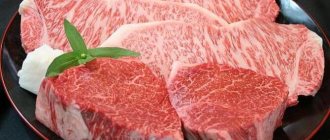The most consumed product around the world is chicken. Its popularity is due to both its delicate taste, ease of preparation, and the economic component - chicken is much cheaper than beef or pork.
When choosing chicken, first of all pay attention to its temperature treatment.
The most common chicken meat on our shelves is:
- chilled (with a temperature from -2 to +4 °C);
- frozen (from -12 °C and below);
- deep frozen (from -18 °C and below inside the carcass).
Give preference to a chilled product.
How to choose the right chilled chicken
Pay attention to the smell, color, size and packaging.
We examine the appearance: the skin of a benign product is clean, pale yellow with a pink tint, and there are no bruises. If the bird is sold without packaging, use your sense of smell: rotten and other foreign odors are a signal to refuse the purchase. Unscrupulous sellers disguise signs of poor quality under marinades and use spices. Of course, not everyone does this, but don’t be lazy, buy a chilled bird and marinate it yourself.
There is another way to check the quality of the product - at home, pierce the chicken with a hot knife, this will help identify the smell of spoilage.
Color
Choose breast: high-quality meat has a pleasant pale pink color. A product stored for a long time loses moisture, becomes dark pink, and when spoiled, turns gray and becomes covered with mucus.
The meat of the legs and thighs , unlike the breast, has a richer, bright pink color, and in poultry it is even red.
Size matters
The distribution network supplies chickens weighing from 400 g and broiler chickens from 640 g. It is better to choose small chicken carcasses weighing 1.5 - 2 kg, in which case you will buy a bird with tender, lean meat.
Package
Chilled poultry is sold packaged in plastic bags or film on trays made of polymer materials. It is important that the packaging is intact and has a label that must include the expiration date, storage conditions, nutritional and energy value of the product.
Fake domestic chicken
As it turned out, many poultry farms, instead of recycling old chickens, simply resell them cheaply to those who later sell them in markets under the guise of domestic chicken. An old laying hen weighs up to 1 kg, and after a short feeding it becomes quite similar to a domestic hen.
Note: Organization of space in the kitchen
Sometimes old chickens are killed right at the factory and then resold to farmers. They prick them with phosphates and color them with carrot juice or iodine. It happens that in this way they get rid of chickens that have died of natural causes.
How to Choose a Good Frozen Chicken
During the freezing process, chicken meat loses some of its nutritional properties, since the resulting ice crystals destroy the cell wall, which leads to the loss of not only water, but also minerals and vitamins. After defrosting (thawing), muscle tissue loses its elasticity, meat, especially those stored for a long time, loses its pleasant taste and aroma. To level out these processes, manufacturers, especially foreign ones, use injection - injecting a saline solution, either containing phosphates, or simply water into the muscle tissue of the bird before freezing. Read the label carefully! If the manufacturer writes that the product is ideal for baking, the softest, etc., then most likely it contains phosphates. This, of course, is not prohibited, but is it worth paying for water?
According to GOST, during defrosting the chicken should become only 4% lighter.
Beginning of the laying hen breeding season
To quickly obtain eggs, chickens should be started at the age of 3.5 to 5 months. It is most convenient to do this in early spring until the end of May. In this case, the peak of chicken productivity will occur in the warm season. This will eliminate the need for additional lighting and heating, reducing the cost of the resulting products.
Farmers and households rarely start raising young animals in winter. Therefore, they do not have stock that will reach maturity in the spring. Small chickens are very sensitive to temperature, and providing conditions is the main criterion when growing. On a small farm, it is unprofitable to heat premises for a small number of chickens, and their mass breeding begins only in the spring.
Poultry farmers who do not want to buy rather expensive grown-up livestock can purchase day-old chicks. In order for them to reach maturity in time for spring, they need to be purchased well in advance in early or mid-winter. In this case, poultry farms come to the rescue, selling chickens constantly, regardless of the season.
- In the Voronezh region, the Aleynikovsky Rossosh hatchery operates, which sells many types of poultry, including laying hens and chicks. The address of the enterprise is Voronezh region, Rossosh, Ukrainsky village, st. Kolkhoznaya, 21 a. Sales department phone number +7 (47396) 79 2 98. Aleynikovsky incubator Rossosh has its own website https://alenikovskij.ru.
- In the Krasnodar region, laying hens from a poultry farm and day-old chicks are sold by the Bryukhovetsky incubator. Production address - Krasnodar region, Bryukhovetsky district, Bryukhovetskaya station, st. Proletarskaya, 312. Bryukhovetsky incubator has its own website https://bruptica.ru, where you can see the schedule according to which sales are made. Company phone number +7 (86156) 33481, 3-16-16.
- In the Republic of Bashkortostan, these products are sold by the Ashkadar poultry farm, which is also known as Sterlitamak. Production address - Sterlitamak district, Sterlitamak, Raevsky tract 18. Telephone.
Storing chicken meat at home
An important factor in product safety is its proper storage at home.
From the moment of production, a chilled poultry carcass is stored for up to 5 days at a temperature from 0 °C to +2 °C. But the catch lies elsewhere: the temperature of an ordinary home refrigerator is usually set at +4 °C +6 °C, plus the time that was spent on delivery to the store and sales, respectively, the storage time at home is reduced to 2, otherwise and up to 24 hours.
The manufacturer, depending on the technological process, can set its own expiration dates. However, if they are unrealistically large, preservatives were used during production.
To be on the safe side, try to cook refrigerated poultry the day you purchase it.
Frozen poultry packaged at -18°C (freezer temperature) can be stored for up to 12 months.
Where and when is the best time to buy?
Let's say right away that it is better to purchase pullet chicken at the age of 4.5-5 months in the spring. Thus, the peak of its productivity will be in the summer - a period of long daylight hours and varied pasture. In the fall, it will be necessary to cull: leave the best layers for the winter and select several new pullets. This way you can renew your livestock and wait for active egg laying after wintering. But one important question still remains: where should you buy laying hens?!
Market or poultry farm?
There are two places where you can buy laying hens - at the market or poultry farm. The pricing policy is not very different, you can easily find the most profitable option. But in this matter the main thing is quality.
Various farmers specializing in breeding bring their goods to the market. The main thing in this case is to carefully examine the chickens for diseases and deficiencies, and feel free to ask the representatives any questions that interest you. Conscientious farmers will be happy to answer you, whether you are a beginner or an experienced person in this matter.
The positive side is that farmers most often have chickens living in fairly spacious conditions, often with walking opportunities. Such chickens are often strong and more resistant to many factors. The disadvantage is the lack of a guarantee for the availability of vaccinations and the irresponsibility of the farmer.
In most cases, chickens are kept at a poultry farm for no more than one year, since they are hybrid and it is more profitable to renew the flock with young animals. They are kept in closed cages and are often fed with compound feed and synthetic additives, which is an undoubted disadvantage. Such chickens may have a low level of immunity, inability to live freely, and a rapid decline in egg production. The positive side is that good factories have all the necessary vaccinations and high productivity in factory conditions.
Pay for the first or second! Selecting chickens by category
Chicken meat is divided into categories 1 and 2 depending on the degree of fatness, as well as on the quality of processing of the carcass.
Fatness of muscle development and the amount of adipose tissue.
A bird of the first category has well-developed muscle tissue, a rounded chest shape, while the keel does not protrude, and the fat is distributed evenly on the stomach, chest and back.
A bird of the second category is characterized by satisfactory muscle development, but at the same time the chest looks angular with a prominent keel and with an insignificant amount of fat, or even its complete absence.
Reference information on the nutritional and energy value of 100 g of carcass of various categories
| Name of carcasses | Protein, g, no less | Fat, including internal fat, g, no more | Energy value of 100 g of product, kcal |
| Chicken carcass 1st grade | 17 | 20 | 250 |
| Chicken carcass 2nd grade | 19 | 11 | 175 |
| Carcass of broiler chickens, 1st grade | 16 | 14 | 190 |
| Carcass of broiler chickens, 2nd grade | 18 | 7 | 135 |
Chickens of the first category should not have bone damage, there may be a small number of scratches on the skin, a maximum of two tears no more than 10 mm in size, but not on the breast! Bruising is unacceptable, and feather stumps must be completely removed.
For chickens of the second category, the requirements are less stringent. Curvature of the keel, up to 3 skin tears of no more than 20 mm, pinpoint hemorrhages and desquamation of the epidermis are allowed. There may be a small amount of feather stumps.
How to keep laying hens
Laying hens are more egg-bearing and tame, and also attractive in appearance. The eggs of this breed are not small and are more tasty. Anyone who keeps chickens at home knows that different breeds have different eggs, and they differ in taste. Chickens of this breed are much more resistant to various diseases, they have stronger immunity.
It is best to keep white hens on your property. With their white coloring, they protect themselves from overheating, and they do not have frequent health problems.
A large number of chickens suffer greatly from mites. How can you protect chickens from it? You need to know that under no circumstances should a winter road be built from wood. It would be best to build it out of brick.
All walls, including internal ones, must be well plastered so that there are no even small cracks.
You should whitewash the walls with lime as often as possible; this smell will repel ticks; they cannot tolerate it.
And this option is a chicken coop in a polycarbonate greenhouse, which is exactly what we have.
How to keep chickens correctly so that they don’t get sick? It is imperative to monitor the cleanliness of the room in which the laying hens are kept, remove droppings from the floor and not allow it to accumulate. You should also sprinkle the entire floor with cast iron filings or small shavings. You can also pour shavings in the corners. Ticks will be afraid of this smell, which will come from cast iron.
If you don't like cleaning up after chickens and smelling chicken aromas? Line the floor of the poultry house with sawdust and straw, 30-40-50 cm thick, and then sprinkle with bacteria. We have a Net layer. So that the litter is processed, releasing heat in winter, and such litter can be changed after 3 seasons.
At least twice a year, preferably in spring and autumn, you will need to disinfect the room. To do this, it will be necessary to temporarily remove the birds to another place.
For proper disinfection, you can burn the middle piece of the rubber cylinder and close this room for a full day, after which you ventilate it and only then release the chickens. The straw in the nests should be changed as often as possible.
It is also allowed to pour a small handful of cast iron shavings or sawdust onto the bottom of the nest, and then cover them well with straw. Chough must be planted earlier so that the mites do not have time to infest themselves. In the summer, it is not recommended to plant a brood hen, otherwise the mite will probably get infested.
Storage
An important role is played by the place where the chicken lies for sale. If in front of you is a counter where chickens are piled up, meat is drying in the sun, and swarms of flies are swarming around, then there is no guarantee of purchasing a healthy product.
According to the rules, meat must be stored in refrigeration units at a temperature of 0 degrees . It’s worth touching the chicken - if the meat is sticky, then the product is stale.
Choosing the right chicken is very important - by purchasing stale products, you risk your health. High-quality chicken meat is very healthy; it contains large amounts of phosphorus and iron. A small amount of fat, compared to other types of meat, makes chicken a dietary product.
Laying hen selection criteria
If the goal is to get eggs immediately and without waiting, then you need to choose birds over 20 weeks old. First of all, laying hens of this age are culled based on their weight.
At 5 months, the weight of good egg breeds is approximately one and a half kilograms. If it is more, then this indicates an admixture of meat trends, and this will directly affect its productivity. A lack of mass will indicate retarded development of the individual.
~5 month old chickens
- Important recommendations on how to choose a laying hen include the condition of its plumage. It should be clean, soft and shiny. The presence of bald spots and growths is unacceptable, which may indicate poor maintenance or impressive age.
- The next method on how to choose the right laying hen is to examine the condition of the feathers around the cloaca. They must be clean; the presence of contamination indicates intestinal diseases such as coccidiosis and others. Dirt is immediately noticeable on sick chickens, and it is contraindicated to allow them into your chicken coop, because the further outcome will be disastrous.
A dirty neck is a reason to think
- Young and healthy individuals have a red comb, while old and sick individuals have a faded comb. If it is cold, then this indicates poor blood circulation in the bird’s body. This condition occurs during illness or with age.
- The beak and legs of pullets are yellow. The eyes should be dry without excessive mucus secretion. This knowledge will help you decide where to begin your inspection to select the appropriate livestock.
Why is "freezing" not used?
“We do not use frozen meat either for sale or for sausages and semi-finished products due to the fact that, firstly, we are able to bring fresh chilled chicken every day. Secondly, when frozen, the quality of raw meat deteriorates significantly, and its beneficial properties are lost, explains production manager Alexey Klinov . “In addition, it is impossible to make juicy semi-finished products from defrosted meat, because frozen meat has lost all its juice during freezing.”
Package
The chicken package should have a mark indicating when it was packaged and the expiration date. According to the norm, the carcass is stored for no more than 6 days, individual parts up to 7-8 days. If you see a longer period, then this is a product treated with preservatives.
The packaging must be marked “chlorine-free.” Previously, meat was treated with special chlorine-containing solutions, which affects the health of the intestines and stomach. Currently, this method of disinfection is not used.

